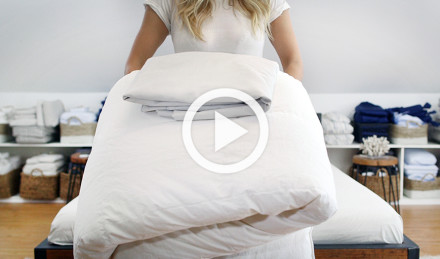When you’re cleaning your home, you probably focus most on the things you notice every day, like floors and countertops. Other less noticeable elements are out of sight and out of mind.
Even if you remember to wash your bedding, it’s easy to let cleaning a mattress slip your mind. But germs, allergens, odors, and stains naturally accumulate on mattresses. So — add periodic mattress cleaning to your regular housekeeping.
If you’re not sure how to clean a mattress correctly, we’ll walk you through the process step by step.
Why It’s Important to Deep Clean Your Mattress
Why It’s Important to Deep Clean Your Mattress
Deep cleaning your mattress isn’t just about removing unsightly stains. More importantly, it helps remove allergens, germs, and odors from your bedroom. Our beds come in contact with sweat, dead skin, hair, dust, dust mites, and other creepy crawlies that most of us prefer not to think about!
Scheduling time to deep clean your mattress correctly ensures you go to sleep in a clean and allergen-free environment. That peace of mind alone is worth the effort.
Consider Mattress Materials When Cleaning
Consider Mattress Materials When Cleaning
Mattresses are made from a range of materials, and each has its own cleaning requirements. For example, you shouldn’t introduce excess moisture to the surface of a memory foam mattress, as it can soak in deep and never fully dry.
Before you start, check to see if there are any instructions for how to clean the mattress provided by the manufacturer.
Best Way to Clean a Mattress: 8 Steps
Cleaning your mattress doesn’t have to feel overwhelming. It’s actually fairly easy as long as you follow these steps.
1: Gather Your Mattress Cleaning Supplies
Start by collecting all your supplies. Here’s what you’ll need:
A vacuum cleaner with an upholstery attachment
Gentle laundry detergent
Baking soda
Cleaning cloths or old towels
Cold water
Enzyme cleaner or dish detergent
2: Strip the Bed and Wash All Bedding
Best Way to Clean a Mattress: 8 Steps
Cleaning your mattress doesn’t have to feel overwhelming. It’s actually fairly easy as long as you follow these steps.
1: Gather Your Mattress Cleaning Supplies
Start by collecting all your supplies. Here’s what you’ll need:
A vacuum cleaner with an upholstery attachment
Gentle laundry detergent
Baking soda
Cleaning cloths or old towels
Cold water
Enzyme cleaner or dish detergent
2: Strip the Bed and Wash All Bedding
Remove the sheets, pillowcases, and bedding and machine wash them. Make sure to wash any mattress pads, mattress toppers, and mattress protectors as well.
It’s a good idea to wash your pillows too. If you’re not sure how to wash pillows, read our helpful guide, Can You Wash Pillows? How to Wash, Dry, & Care for Pillows.
For ideas on how to wash sheets and bedding, see How to Wash, Dry, and Care for Organic Cotton Sheets, Towels, and Clothes.
3: Vacuum Your Mattress
Your home vacuum is an important tool for deep cleaning mattresses. Using the upholstery attachment, slowly vacuum the top and sides of your mattress. Consider vacuuming in a grid pattern so you can keep track of where you’ve already vacuumed.
After vacuuming the flat surfaces, pay special attention to the seams. Dirt, dust, and insects can build up there.
4: How to Remove Mattress Stains
Mattress stains are a common problem, especially if you sweat when you sleep. Spot cleaning is the best way to beat mattress stains. Create a diluted detergent solution with gentle laundry detergent or dish soap and water.
Using a cleaning cloth or towel, dab the solution on the stain and lightly scrub until it fades. Soak up any excess moisture with a dry towel.
If your mattress has blood stains, an enzyme cleaner and cold water can remove them. Cold water can help break down proteins in blood.
Remember that stains are always easiest to remove if you address them right when they happen. In between deep cleanings, laundry detergent wipes are a quick and easy way to prevent staining.
5: Sprinkle Your Mattress with Baking Soda and Vacuum
Baking soda is an excellent tool to deodorize your mattress. Sprinkle an even layer across the top surface of your mattress and let it sit.
Once the baking soda has had a chance to absorb any lingering odors, thoroughly vacuum the mattress to ensure a clean, dry surface.
6: Flip Your Mattress
If you have a two-sided mattress, flip it every time you do a deep cleaning. Flipping a mattress helps prolong its life by evenly distributing wear and tear.
Once you’ve flipped it, repeat the vacuuming, stain removal, and baking soda steps on this side of the mattress if needed.
If you have a mattress with a built-in pillow top or memory foam layer, you won’t be able to flip it, but you can rotate it.
7: Clean Your Bed Frame
When doing routine mattress and bed cleaning, address your bed frame as well, to remove dust, dead skin, or hair.
You can clean upholstered bed frames using the same techniques as your mattress, but be careful with detergent as it may cause discoloration. Check the manufacturer’s cleaning instructions for guidance.
For wood and metal bed frames, use a disinfectant solution and a rag. Let the bed frame dry completely before replacing the mattress and bedding.
8: Cover Your Clean Mattress with a Mattress Protector
Using a mattress protector will help keep your mattress stain and odor free in the future. Waterproof mattress protectors are helpful for people who sweat heavily and for young children, but in most other cases, a cotton mattress protector is all you need.
Do you need to store your mattress? See our guide: How To Store A Mattress for a complete how-to.
Common Questions About Mattress Cleaning
Now that you know how to clean a mattress, here are some other common questions and answers.
How Often Should I Clean My Mattress?
You should deep clean your mattress about every six months and spot-clean spills as they happen.
How Long to Let Baking Soda Sit on a Mattress?
For best results, baking soda should stay on your mattress for six to eight hours. Start the mattress cleaning process first thing in the morning so you have plenty of time for each step before bedtime.
Can You Wash a Mattress?
Adding more than just a little water or liquid cleaner to any mattress isn’t a good idea. Too much water can take a long time to dry out and may cause mildew. Surface cleaning a dirty mattress is always the best option.
When is it Time to Replace My Mattress?
Most mattresses have a seven to ten-year life span, though it’s a good idea to replace your mattress if you start to notice a decline in your sleep quality. Noticeable sags, lumps, squeaky springs, or extreme allergies that get worse over time are all good reasons to buy a new mattress.
Check out our Decision-Making Guide for Buying the Right Mattress for more.
If you notice deterioration in your pillows, mattress pads, or bed linens, you may want to replace those as well. For more information, explore our guide How Often to Replace Sheets, Pillows, and Other Bed Linens.
Common Questions About Mattress Cleaning
Now that you know how to clean a mattress, here are some other common questions and answers.
How Often Should I Clean My Mattress?
You should deep clean your mattress about every six months and spot-clean spills as they happen.
How Long to Let Baking Soda Sit on a Mattress?
For best results, baking soda should stay on your mattress for six to eight hours. Start the mattress cleaning process first thing in the morning so you have plenty of time for each step before bedtime.
Can You Wash a Mattress?
Adding more than just a little water or liquid cleaner to any mattress isn’t a good idea. Too much water can take a long time to dry out and may cause mildew. Surface cleaning a dirty mattress is always the best option.
When is it Time to Replace My Mattress?
Most mattresses have a seven to ten-year life span, though it’s a good idea to replace your mattress if you start to notice a decline in your sleep quality. Noticeable sags, lumps, squeaky springs, or extreme allergies that get worse over time are all good reasons to buy a new mattress.
Check out our Decision-Making Guide for Buying the Right Mattress for more.
If you notice deterioration in your pillows, mattress pads, or bed linens, you may want to replace those as well. For more information, explore our guide How Often to Replace Sheets, Pillows, and Other Bed Linens.
Choose Fresh, Healthy, and Eco-Friendly Mattresses and Bedding
Choose Fresh, Healthy, and Eco-Friendly Mattresses and Bedding
Your bed and mattress are important to your home. They directly impact your quality of sleep and the energy you feel during the day.
Maintaining a clean mattress goes a long way to help you avoid allergens, odors, and germs that disrupt your sleep. Investing in a high-quality, eco-friendly mattress is another step you can take for comfortable, supported sleep.
Parachute is a great resource for long-lasting, environmentally friendly, comfortable, and attractive pillows, linens, decor, and furniture for your home. Invest in the sense of harmony a wonderfully appointed home provides.










